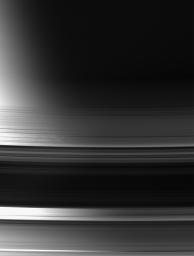
|
Seeing the Difference
- Click the image above for a larger view
- Full-Res JPEG (772 x 1019) (34.3 kB)
- Full-Res TIFF (772 x 1019) (787.7 kB)
Caption:
With Saturn's terminator as a backdrop, this view of the unlit face of the rings makes it easy to distinguish between areas that are actual gaps, where light passes through essentially unimpeded, and areas where the rings block or scatter light. The gaps are regions in which the brightness varies strongly from left to right as the background goes from bright to dark.
Parts of the image are saturated at left.
The image was taken in visible light with the Cassini spacecraft wide-angle camera on July 24, 2006 at a distance of approximately 577,000 kilometers (359,000 miles) from Saturn and at a Sun-Saturn-spacecraft, or phase, angle of 101 degrees. Image scale is 31 kilometers (19 miles) per pixel.
Background Info:
The Cassini-Huygens mission is a cooperative project of NASA, the European Space Agency and the Italian Space Agency. The Jet Propulsion Laboratory, a division of the California Institute of Technology in Pasadena, manages the mission for NASA's Science Mission Directorate, Washington, D.C. The Cassini orbiter and its two onboard cameras were designed, developed and assembled at JPL. The imaging operations center is based at the Space Science Institute in Boulder, Colo.
For more information about the Cassini-Huygens mission visit http://saturn.jpl.nasa.gov/home/index.cfm . The Cassini imaging team homepage is at http://ciclops.org .
Cataloging Keywords:
| Name | Value | Additional Values |
|---|---|---|
| Target | Saturn Rings | Saturn |
| System | Saturn | |
| Target Type | Ring | Planet |
| Mission | Cassini-Huygens | |
| Instrument Host | Cassini Orbiter | |
| Host Type | Orbiter | |
| Instrument | Imaging Science Subsystem (ISS) | |
| Detector | Wide Angle Camera | |
| Extra Keywords | Grayscale, Visual | |
| Acquisition Date | ||
| Release Date | 2006-08-23 | |
| Date in Caption | 2006-07-24 | |
| Image Credit | NASA/JPL/Space Science Institute | |
| Source | photojournal.jpl.nasa.gov/catalog/PIA08250 | |
| Identifier | PIA08250 | |
